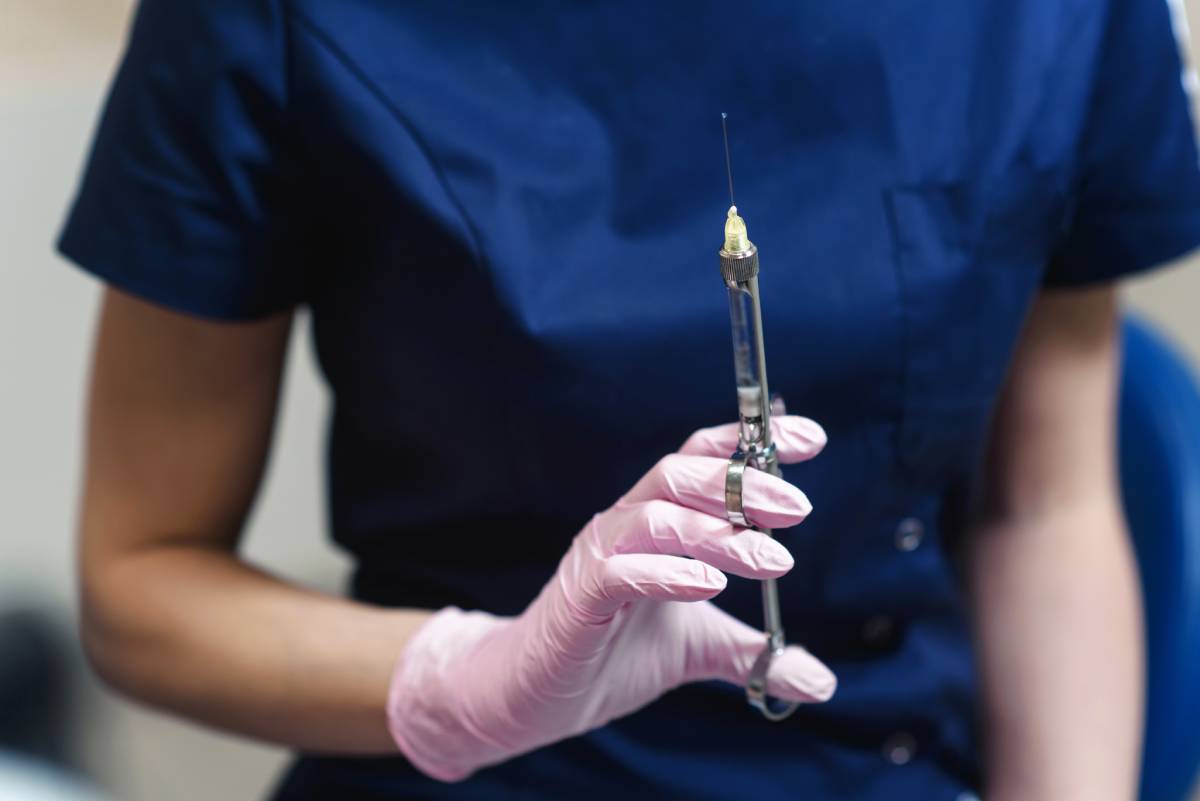Lidocaine is an intermediate-acting local anesthetic commonly used in surgical, obstetrical, and diagnostic procedure.1 This tertiary amine was first synthesized in the 1940s and quickly replaced several anesthetics in use at the time as a safer alternative.2 It is commonly administered with epinephrine to extend its duration of action and help prevent bleeding.3
Lidocaine induces numbing by diffusing through neural sheaths and localizing to sodium channels, thus blocking the influx of sodium ions and preventing nerve depolarization.4 It has been found to have reduced efficacy in inflammatory conditions, which may be caused by an increase in blood flow or more acidic conditions that decrease the amount of un-ionized lidocaine molecules (the charged form is much less effective at diffusing through the cell membrane and subsequently acting on sodium channels).3
It is most commonly used as a local numbing agent. In dental applications, a dilute solution is injected as close to the target nerve as possible. It is also commonly used to relieve the pain of post-herpetic neuralgia, the pain that can last months after a shingles infection, in the form of a transdermal patch.5 These patches usually consist of 5% lidocaine and can be used to treat pain from other sources, like post-operative nerve pain and compressed nerves. Traditionally, it has also been known to treat ventricular arrythmias, particularly ventricular tachycardia and multiple ventricular extrasystoles.6 However, more recent research suggests that, contrary to what was once believed, administering lidocaine prophylactically has a negligible effect on people who have experienced a myocardial infarction.7
Though rare, adverse side effects of lidocaine have been observed. Most side effects are caused by toxic levels of lidocaine concentration in the plasma.3 This local anesthetic reaches toxic concentrations most easily when administered into the intercostal space, as it reaches the intravascular compartment most rapidly this way (as opposed to administration through the caudal, epidural, and subcutaneous spaces).3 More so than other anesthetics, lidocaine is associated with transient radicular irritation syndrome,8 which is lower extremity pain experienced after receiving spinal anesthesia.9 The drug is metabolized in the liver by the cytochrome CYP3A4, so any drugs that are also ligands of this can cause elevated lidocaine serum levels and may cause toxicity.10
It has several contraindications. There are several cases in the literature of lidocaine-induced methemoglobinemia,11 a condition in which the iron in hemoglobin is stabilized in the ferric (Fe3+) form and cannot bind oxygen, which leads to tissue hypoxia.12 At high concentrations, it and other oxidizing drugs can convert hemoglobin to methemoglobin. Becker et al. stress the importance of hemodynamic monitoring when administering lidocaine with epinephrine or other vasoconstrictors, as, even in small doses, they can cause significant cardiovascular effects.3
Foo et al. recently published a guide to using it intravenously in Anaesthesia, in which they recommend that infusions be given only in settings with continuous monitoring and after approval by the hospital.13 Lidocaine, the authors conclude, is a reliable and safe anesthetic that should be used by medical practitioners under the right conditions whenever it is needed.
References
1. “Lidocaine (Local) Monograph for Professionals.” Drugs.com.
2. Calatayud, J., and González, A. “History of the Development and Evolution of Local Anesthesia Since the Coca Leaf.” Anesthesiology, vol. 98, no. 6, 2003, pp. 1503–1508., doi:10.1097/00000542-200306000-00031.
3. Beecham GB, Bansal P, Nessel TA, et al. Lidocaine. [Updated 2021 Jan 26]. In: StatPearls [Internet]. Treasure Island (FL): StatPearls Publishing; 2021 Jan-. Available from: https://www.ncbi.nlm.nih.gov/books/NBK539881
4. Lidocaine: A Common Local Anesthetic. The University of Reading.
5. “Lidocaine Transdermal Patch: MedlinePlus Drug Information.” MedlinePlus, U.S. National Library of Medicine, medlineplus.gov/druginfo/meds/a603026.html.
6. Gianelly, R., et al. “Effect of Lidocaine on Ventricular Arrhythmias in Patients with Coronary Heart Disease.” New England Journal of Medicine, vol. 277, no. 23, 1967, pp. 1215–1219., doi:10.1056/nejm196712072772301.
7. Martí-Carvajal, A., et al. “Prophylactic Lidocaine for Myocardial Infarction.” Cochrane Database of Systematic Reviews, 2015, doi:10.1002/14651858.cd008553.pub2.
8. Zaric, D, et al. “Transient Neurologic Symptoms (TNS) Following Spinal Anaesthesia with Lidocaine versus Other Local Anaesthetics.” Cochrane Database of Systematic Reviews, 2003, doi:10.1002/14651858.cd003006.
9. Lambert, D. “Transient Radicular Irritation Remains a Danger.” Anesthesia Patient Safety Foundation, 20 Oct. 2019, www.apsf.org/article/transient-radicular-irritation-remains-a-danger/.
10. Fang, P., et al. “Functional Assessment of CYP3A4 Allelic Variants on Lidocaine Metabolism in Vitro.” Drug Design, Development and Therapy, Volume 11, 2017, pp. 3503–3510., doi:10.2147/dddt.s152366.
11. Chowdhary, S., et al. “Risk of Topical Anesthetic–Induced Methemoglobinemia.” JAMA Internal Medicine, vol. 173, no. 9, 2013, p. 771., doi:10.1001/jamainternmed.2013.75.
12. Barash, M., et al. “Lidocaine-Induced Methemoglobinemia: A Clinical Reminder.” The Journal of the American Osteopathic Association, 2015, doi:10.7556/jaoa.2015.020.
13. Foo, I., et al. “The Use of Intravenous Lidocaine for Postoperative Pain and Recovery: International Consensus Statement on Efficacy and Safety.” Anaesthesia, vol. 76, no. 2, 2020, pp. 238–250., doi:10.1111/anae.15270.










